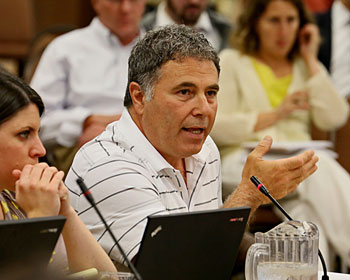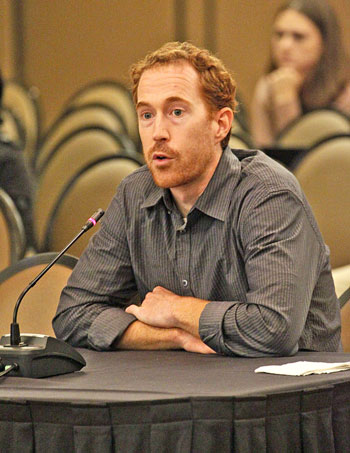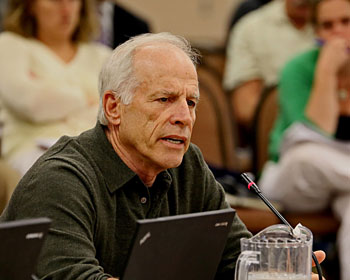11th Hour G’Fish Brawl
continued from Homepage

“We need to reduce effort because there are too many people fishing,” said SAC member Erin Owen, a fishery scientist at Husson College. “And it’s not clear to me that freezing the licenses would impact that.” Chessie Crowe Gartmayer Photo
“I think everyone is struggling right now with the low ACLs. No matter where you are or what kind of vessel you fish from or what kind of groundfish you catch, everyone’s in trouble,” Dority said. The NEFMC can cap permits, he said, “But we can do better to look at how to provide access in the future.”
“Something’s got to change,” said NEFMC member Tom Dempsey, who is policy director with the Cape Cod Commercial Hook Fishermen’s Association. “We have a groundfish resource at a fraction of what it used to be, and we’re still not turning the tide on that.”
Gloucester, Mass., fisherman Jim Ford, captain of FV Lisa Ann II, wrote to NEFMC regarding his difficulties dealing with the low yellowtail quota: “I am going to try my hardest to continue to make a living fishing, but I am getting to the point that I am pretty scared that I might not be able to continue with such low limits and high cost of quota.”
David Goethel, a New Hampshire fisherman and member of the NEFMC, in a May 24 letter to National Marine Fisheries Service (NMFS) northeast regional administrator John Bullard, wrote of an incident last year, when yellowtail was at 60 cents per pound. After paying for his vessel’s fuel, ice, permit, shipping and handling, he wrote, he was able to issue a check of only $5.84 to one of his crewmen, for a week’s worth of work.
On May 30, Massachusetts attorney general Martha Coakley filed suit against the National Oceanic and Atmospheric Administration (NOAA) and NMFS to challenge interim rules, known as Framework 48 and 50 to the groundfish management plan, that became effective with the start of the 2013 fishing season on May 1. The suit says the impact of the rules on the families and small businesses that earn their living fishing groundfish, and on the communities where they reside, are “devastating,” and “threatening the extinction of an industry that for more than a century has been part of the commercial and social fabric of New England, especially Massachusetts.”
The suit claims the rules are in violation the federal fishery law known as the Magnuson-Stevens Act.
According to the suit, “NOAA and the Secretary failed to conform to the statutory safeguards enacted to balance the twin goals of environmental protection and sustainable access to the fisheries, by, among other things: a) failing to achieve optimum yield from the New England groundfish fisheries, b) dictating conservation and management measures that are not based on the best scientific information available, c) failing to meaningfully take into account the importance of fishery resources to fishing communities, and d) refusing to meaningfully provide for the sustained participation of, or to minimize the adverse effects upon, those fishing communities.”
The rules contained “no meaningful measures to mitigate the devastating economic impacts” of the 77 percent cut, the suit says.
The suit says the rules relied on “highly suspect science,” particularly with regard to the latest assessments of Gulf of Maine cod, Georges Bank cod, and Southern New England/Massachusetts yellowtail flounder.
The suit asks for an injunction against the rules because they are “arbitrary, capricious, an abuse of discretion and otherwise not in accordance with the Magnuson-Stevens Act.” The rules “fail to achieve optimum yield from the Northeast Multispecies Fishery, are not based on the best scientific information available, and fail to minimize adverse economic impacts on Massachusetts fishing communities.”
Massachusetts fishermen expressed support of Coakley’s challenge. Prepared statements included the following:
“Scientists projected that the key stocks our fishery depends on would be rebuilt by 2014,” said Jackie Odell, executive director of the Northeast Seafood Coalition. “Despite doing their part to rebuild fish stocks, small fishing-dependent businesses have had the rug pulled out from under them.”
Said Scott Memhard, president of Cape Pond Ice Company: “For more than 30 years, my family (my father, myself, now my son) has owned and operated the Cape Pond Ice Company, since 1998 the only plant in Gloucester supplying the fishing fleet with ice. Our sales to fishing vessels dropped from 40,000 tons of ice a year to only 4,000 tons last year, and are already on track to be cut in half again this year, based on new federal catch share quota limits.
Joe Orlando, owner and operator of F/V Padre Pio, a 65-foot trawl vessel based out of Gloucester, said, “My livelihood has been slashed before my eyes because the scientific reports changed so drastically. We won’t be allowed to bring in enough catch this year to even pay my business’ debts. I am in financial ruin. This fishery is in a disaster and we need help.”
Vito Giacalone, a third-generation commercial fisherman and executive director of the Gloucester Fishing Community Preservation Fund, said, “This isn’t a battle about conservation versus fishing industry; this is an effort to strike a balance to rebuild fish and preserve fishery-dependent businesses. We’re not currently doing a good job of striking that balance. One example of this, is the denial of requested interim measures that would have rebuilt Gulf of Maine cod by 14 percent without decimating the fleet.”

“We need to reduce effort because there are too many people fishing,” said SAC member Erin Owen, a fishery scientist at Husson College. “And it’s not clear to me that freezing the licenses would impact that.” Chessie Crowe Gartmayer Photo
The Massachusetts congressional delegation said it would pursue disaster relief funding for the industry.
New Bedford Mayor Jonathan Mitchell said the groundfish cuts will “devastate” the state’s fishing communities.
“The federal government did not properly take into account economic and social data before implementing the cuts,” Mitchell said in a prepared statement.
At AG Coakley's May 30th press conference where the NOAA lawsuit was announced, Massachusetts State Representative Ann-Margaret Ferrante said, “When you look at Joe [Orlando] and when you look at Vito [Giacalone], I don’t want you just to see two fishermen who are facing hard times. I want you to see the lifeblood of my community, the heritage of my community.” (See sidebar page 7 for complete transcription of Ferrante’s comments.)
The Conservation Law Foundation (CLF) denounced Coakley’s lawsuit. CLF issued the following statement from Peter Shelley, senior counsel:
“Political interference like this action by Attorney General Coakley has been a leading cause of the destruction of these fisheries over the past 20 years, harassing fishery managers to ignore the best science available. The fishing industry didn’t catch the fish they were allocated last year because the fish are not there. We need responsible management which includes habitat protection and a suspension of directed commercial and recreational fishing for cod.”
On May 31, CLF launched two lawsuits against NOAA and NMFS to challenge NMFS’ plan to open several groundfish conservation areas in New England; and to challenge a plan to boost 2013 catch limits for several New England groundfish stocks “beyond the allowable science-based limits by ‘carrying over’ ten percent of the catch quota from 2012 that fishermen were unable to catch.”
In September 2012, the U.S. Department of Commerce declared a commercial fishery failure in the Northeast groundfish fishery for the 2013 fishing season.
Fishermen have said they are not satisfied with the science methods used to assess the status of the groundfish stocks. On that track, on June 10, Coakley also asked her state legislature to keep funding for fisheries research within the proposed 2014 budget. In a statement, she said the research “is critically needed because it would allow for sonar or other methods to determine an independent count of the number of groundfish in New England waters.”
At a May 21 hearing, a House subcommittee called the Magnuson-Stevens Reauthorization Oversight Committee heard from Dr. Kevin Stokesbury, associate professor and chair of the Department of Fisheries Oceanography at the University of Massachusetts-Dartmouth’s School for Marine Science and Technology (SMAST), who testified on fisheries data collection. The subcommittee asked Stokesbury if alternative survey methods now in use for the sea scallop fishery could apply to the ground fishery. Stokesbury spoke to the scientist/fishermen cooperative techniques that helped double of the measures of scallop abundance worth approximately $2.4 billion.
The current situation with groundfish, he said, represents a stark contrast. “Scientific uncertainties are huge and many fishermen are saying, ‘This is it, it’s over,’” he said. Stokesbury advocated for a return to the “fundamental principles of field ecology” that can help to determine an “absolute measure” of abundance and determine associated uncertainties.
For the scallop fishery, he said, “Working with fishermen, we tried to avoid preconceived notions.”
Fishermen outlined historic fishing grounds and donated time and fuel to the effort, which created a quadrat system for scallop counts. The system has been approved by NMFS and has been published in 25 peer-reviewed scientific papers.
“What’s the future?” he said. “The biggest question in fisheries continues to be the relationship between spawning adults and new recruits.” The trick, he said, is having the scientific techniques to see recruits as they occur. His team, he said, is working on new acoustic and video techniques to measure groundfish and fishing impacts – for example, placing a video camera on the cod end of a trawl, which is expected to sample on an order of magnitude more sea floor.
“To me, the way forward is to get out there, and work with the fishermen measuring what’s going on. If we can use new technologies to look at these populations clearly and simply, perhaps we can start grasping their underlying dynamics,” Stokesbury said.
On a different but related track, the NEFMC is considering potential rules intended to help fishermen cope with the quota cuts. The actions under consideration comprise Amendment 18 to the groundfish management plan. One of the goals is to “reduce the likelihood that groundfish permit holders will acquire or control excessive shares of fishing privileges in the fishery and that over-consolidation will occur within the fleet.”
According to NEFMC documents, “Currently, there are no specific controls on the excessive accumulation or control of fishing privileges in the multispecies fishery. There is concern that the low catch limits, in conjunction with expanded sector management, will lead to excessive consolidation and lack of diversity in the groundfish fleet. Likewise, there is concern regarding consolidation and diversity in the groundfish fleet as stocks rebuild and acceptable biological catches (ABCs) increase.”
The goals of Amendment 18 are also to maintain inshore and offshore fleets; maintain a diverse groundfish fishery, including different gear types, vessel sizes, geographic locations, and levels of participation; maintain a balance in the geographic distribution of permits to protect fishing communities and the infrastructure they provide; and prohibit any person or government entity from acquiring or controlling excessive access to the resource, though in order to prevent extraction of disproportionate “economic rents” from other permit-holders.

“We need to reduce effort because there are too many people fishing,” said SAC member Erin Owen, a fishery scientist at Husson College. “And it’s not clear to me that freezing the licenses would impact that.” Chessie Crowe Gartmayer Photo
A public permit bank is a NOAA-sponsored, state-operated mechanism that allows an entity to obtain federal permits and allocate fishing privileges. According to NEFMC, there is no standard definition for a private permit bank; the term is generally used to refer to nonprofit organizations that hold fishing permits.
CLF’s Shelley said part of protecting the diversity of the fleet involves identifying the types of vessels that comprise the fleet. Trip boats and day boats, he said, “have somehow managed to get through this really difficult situation with groundfish, but if you just focus on accumulation caps in this amendment, you’ll miss an opportunity to do something really meaningful in terms of the structure of the groundfishery.”
NEFMC member David Pierce said the action “indicates we would rely solely on sectors and permit banks….Sectors have done great work, good leadership, great ideas, but we’ve got a ways to go regarding sectors and permit banks. They are evolving and we are still trying to understand how they function.”
Said Pierce, “I appreciate the concerns of the industry, who are so fearful of the current situation, and the situation of their members.” With the cuts in the ACLs, “We have a groundfish fishery disaster. They’re dealing with that, and they’re trying to preserve every opportunity to move fish around…I’m sensitive to their concerns. They’re still standing and I want them to still stand. But I’ve got to look forward to the future.”
Bullard, said the action is not strong enough in addressing the issue of consolidation. The industry can have a diverse fleet – but all owned by one entity, he pointed out. “I think that losing any reference to excessive shares and accumulation limits is a mistake,” Bullard said. “Permit banks are wonderful, but relying on them for protection – they’re not a big enough player for that.”
“Trade restraints would limit sectors’ ability to pursue their own diversity goals, such as providing allocation to new entrants, or giving preference to owner-operators, specific vessel classes, and/or gear t types,” the AP said.
In a letter to NEFMC, Portland fishermen Brian and Tracy Pearce wrote, regarding “what is happening in the groundfish industry specific to high cost of leasing and consolidation…Many people are choosing to forego fishing and there are no new entrants, who might offer new and resourceful ideas, due to the high cost associated with leasing quota of select species.”
The Pearces asked NEFMC to impose a limit on the price of leasing.
In his letter to Bullard, Goethel noted trends that have become apparent in the new fishing year.
“The first none of us can solve, but it is disturbing just the same,” Goethel wrote. “The people selling their boats, and in some cases permits, are the handful of younger owners in the fleet. This is disturbing to me because these are the people we will need most to transfer the knowledge of fishing as my generation retire or die. This is not unexpected, however, as all the exiting owners have expressed similar sentiments. First, they believe groundfish management is completely dysfunctional and will never be fixed. Second, they are carrying mortgages on vessels and permits which they can no longer pay. Older people are more likely to have less debt, plus they are basically unemployable in this economy and have no choice but to stay.”
Goethel continued: “The second trend, which is helping to drive the first is the exorbitant price of leased fish. Prices being offered on inshore stocks are currently in excess of the landed value. For example, live weight [Gulf of Maine] cod are being leased for $2-$2.40 per pound (approximately $2.40-$2.80 landed weight), [Gulf of Maine] haddock $1.50, [Cape Cod/Gulf of Maine] yellowtail $1.20-$1.30, and witch flounder $.125-$1.40. Contrast this with average landed value of yellowtail from the Cape Ann seafood exchange for May 24, 2013 which was 99 cents per pound. The problem is being further exacerbated by people selling entire allocations as blocks. This means one has to take the entire amount and suite of species regardless of what you need or can afford. The result is numbers entirely outside the range of small boats.…We are talking about wholesale extortion of our hardworking captains and crews who actually fish, by those that do not.”
Goethel asked Bullard to consider imposing price controls on leased fish. “Absent immediate action, amendment 18 will be irrelevant,” Goethel wrote. “Many captains and crews face dire circumstances. They can fish out their gifted allocation in a matter of days and then starve for the rest of the year as self-employed captains and crews cannot collect unemployment. The alternative is to lease fish at these prices and still starve.”
Amendment 18 is tentatively scheduled for implementation in 2015.
